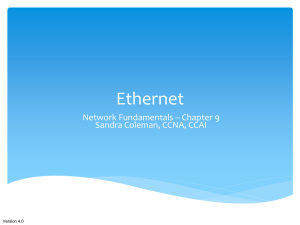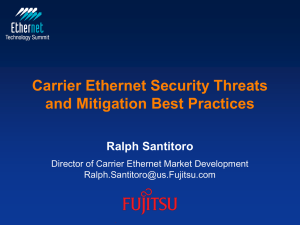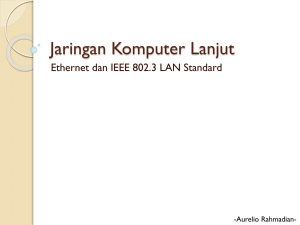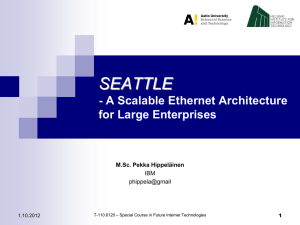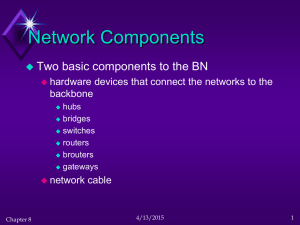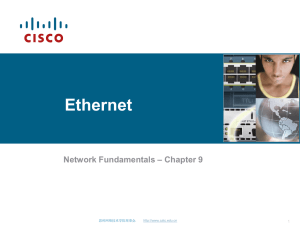Data centre networking
advertisement
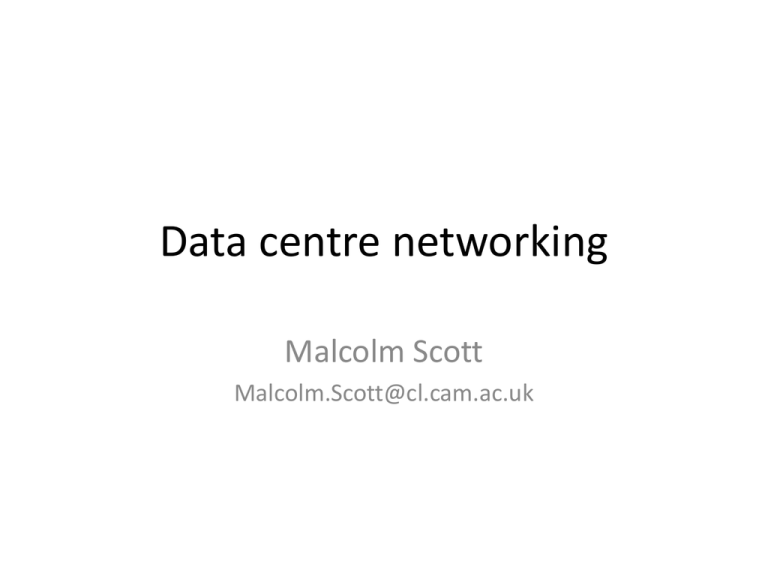
Data centre networking Malcolm Scott Malcolm.Scott@cl.cam.ac.uk Who am I? • Malcolm Scott – 1st year PhD student supervised by Jon Crowcroft – Researching: • Large-scale layer-2 networking • Intelligent energy-aware networks – Started this work as a Research Assistant • Also working for Jon Crowcroft – Working with Internet Engineering Task Force (IETF) to produce industry standard protocol specifications for large data centre networks What I’ll talk about • • • • Overview / revision of Ethernet The data centre scenario: why Ethernet? Why Ethernet scales poorly What we can do to fix it – Current research OVERVIEW OF ETHERNET Ethernet: 1970s version • Shared medium (coaxial cable) – Every host receives every frame – How does a host tell which frames to process? Ethernet: 1970s: addressing • Each interface has a unique MAC address – 00:1f:d0:ad:cb:2a Assigned by the manufacturer Identifies the manufacturer • Frame header contains source and destination addresses • NIC filters incoming packets by destination • Group addresses for broadcast/multicast Ethernet: modern day version • Shared medium = poor performance • Instead, use point-to-point links and switches Ethernet: switching • Switch learns the location of a MAC address when it first sees a frame from that address – Forwarding database (FDB) stores mapping from MAC address to physical port – Since control messages (ARP, DHCP, ...) are broadcast, this will be refreshed often • Switch forwards frames using FDB – Floods frames where destination is not known Ethernet in the OSI model OSI layer Functions ... ... Standard 3 – Network IP; routing 2¼? Ethernet switching (“MAC bridges”) 2 – Data link Ethernet MAC (addressing, etc.) 1 – Physical Ethernet PHY (“Gigabit Ethernet”: 1000BASE-T, etc.) IEEE 802.1D IEEE 802.3 • “Ethernet” means three different things • Switch behaviour is specified separately from the rest of Ethernet • (Originally bridging: join together shared-medium Ethernets) Ethernet and IP • Applications communicate using IP addresses (or hostnames), not MAC addresses • Therefore, hosts need to convert IP addresses into MAC addresses • ARP (Address Resolution Protocol): – Broadcast request (to ff:ff:ff:ff:ff:ff): “who has IP address 78.129.234.130?” – Unicast reply (to sender of request): “78.129.234.130 is 00:1f:d0:ad:cb:2a” Ethernet: assorted extra features • Virtual LANs (VLANs, 802.1q): – Multiple isolated networks (IP subnets) using a single Ethernet infrastructure – Tag frames with VLAN ID – Very widely used in data centres • Spanning tree protocol, (R)STP: – Switches cannot cope with loops • Broadcast frames would go around forever: no TTL – RSTP disables redundant links to remove loops Spanning tree switching illustrated Spanning tree switching illustrated destination THE DATA CENTRE SCENARIO Virtualisation is key • • • • Make efficient use of hardware Scale apps up/down as needed Migrate off failing hardware Migrate onto new hardware – All without interrupting the VM (much) Virtual machine migration • VM memory image transferred between physical servers • Apps keep running; connections stay open – Must not change IP address – Therefore, can only migrate within subnet • Ideally, allow any VM to run on any server – So entire data centre (or multiple data centres!) must be one Ethernet The scale of the problem • Microsoft: 100,000 physical servers • ...And then virtualisation: tens of virtual machines per server • ...All on one Ethernet – Servers contain virtual switches to link VMs together and to the data centre LAN • Segregate traffic using VLANs – But every VLAN must reach every physical server Data centre topology: rack Servers “Top” of rack (ToR) switch Data centre entropy Data centre entropy Data centre topology: row ToR switches End-of-Row (EoR) switch Data centre topology: core EoR EoR Core switch EoR EoR EoR EoR Rows of server racks Basically a tree topology (but with redundant EoRs, becomes a “fat tree”) Data centre topology: multi-centre Data centre 2 Data centre 1 No longer a tree! Data centre 3 ETHERNET SCALABILITY So what goes wrong? • Volume of broadcast traffic – Can extrapolate from measurements – Carnegie Mellon CS LAN, one day in 2004: 2456 hosts, peak 1150 ARPs per second [Myers et al] – For 1 million hosts, expect peak of 468000 ARPs per second • Or 239 Mbps! – Conclusion: ARP scales terribly – (However, IPv6 ND may manage better) So what goes wrong? • Forwarding database size: – Typical ToR FDB capacity: 16K-64K addresses • Must be very fast: address lookup for every frame – Can be enlarged using TCAM, but expensive and power-hungry – Since hosts frequently broadcast, every switch FDB will try to store every MAC address in use – Full FDB means flooding a large proportion of traffic, if you’re lucky... So what goes wrong? • Spanning tree: – Inefficient use of link capacity – Causes congestion, especially around root of tree – Causes additional latency • Shortest-path routing would be nice Data centre operators’ perspective • Industry is moving to ever larger data centres – Starting to rewrite apps to fit the data centre (EC2) – Data centre as a single computer (Google) • Google: “network is the key to reducing cost” – Currently the network hinders rather than helps Current research HOW TO FIX ETHERNET Ethernet’s underlying problem MAC addresses provide no location information (NB: This is my take on the problem; others have tackled the problem differently) Flat vs. Hierarchical address spaces • Flat-addressed Ethernet: manufacturer-assigned MAC address valid anywhere on any network – But every switch must discover and store the location of every host • Hierarchical addresses: address depends on location – Route frames according to successive stages of hierarchy – No large forwarding databases needed Hierarchical addresses: how? • Ethernet provides facility for Locally-Administered Addresses (LAAs) • Perhaps these could be configured in each host based on its current location – By virtual machine management layer? • Better (more generic): do this automatically – but Ethernet is not geared up for this – No “Layer 2 DHCP” MOOSE Multi-level Origin-Organised Scalable Ethernet • A new way to switch Ethernet – Perform MAC address rewriting on ingress – Enforce dynamic hierarchical addressing – No host configuration required • Transparent: appears to connected equipment as standard Ethernet • Also, a stepping-stone to shortest-path routing (My research) MOOSE • Switches assign each host a MOOSE address switch ID : host ID • Placed in Ethernet source address in each frame • No encapsulation: no rewriting of destination address – (would require another large table, equivalent to FDB) The journey of a frame Host: “00:16:17:6D:B7:CF” New frame, so rewrite 02:11:11 02:22:22 02:33:33 Host: “00:0C:F1:DF:6A:84” From: 00:16:17:6D:B7:CF To: broadcast From: 02:11:11:00:00:01 To: broadcast The return journey of a frame Host: “00:16:17:6D:B7:CF” Destination is local Destination is on 02:11:11 Destination New frame,is on so02:11:11 rewrite 02:11:11 From: 02:33:33:00:00:01 To: 00:16:17:6D:B7:CF 02:22:22 02:33:33 Host: “00:0C:F1:DF:6A:84” From: 02:33:33:00:00:01 To: 02:11:11:00:00:01 From: 00:0C:F1:DF:6A:84 To: 02:11:11:00:00:01 Shortest path routing • MOOSE switch ≈ layer 3 router – One “subnet” per switch • E.g. “02:11:11:00:00:00/24” – Run a routing protocol between switches • Multipath-capable, ideally: OSPF-ECMP? What about ARP? • One solution: cache and proxy – Switches intercept ARP requests, and reply immediately if they can; otherwise, cache the answer when it appears for future use • ARP Reduction (Shah et al): switches maintain separate, independent caches • ELK (me): switches participate in a distributed directory service (convert broadcast ARP request into unicast) • SEATTLE (Kim et al): switches run a distributed hash table Open questions • How much does MOOSE help? – Simulate it and see (Richard Whitehouse) • How much do ARP reduction techniques help? – Implement it and see (Ishaan Aggarwal) • How much better is IPv6 Neighbour Discovery? – In theory, fixes the ARP problem entirely • But only if switches understand IPv6 multicast • And only if NICs can track numerous multicast groups – No data, just speculation... • Internet Engineering Task Force want someone to get data! • How much can VM management layer help? Conclusions • Data centre operators want large Ethernet-based subnets • But Ethernet as it stands can’t cope – (Currently hack around this: MPLS, MAC-in-MAC...) • Need to fix: – FDB use – ARP volume – Spanning tree • Active efforts (in academia and IETF) to come up with new standards to solve these problems Thank you! Malcolm Scott Malcolm.Scott@cl.cam.ac.uk http://www.cl.cam.ac.uk/~mas90/

